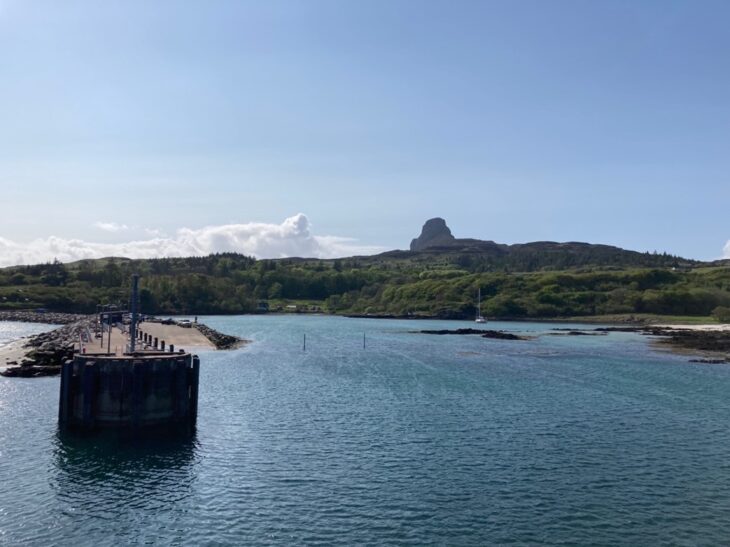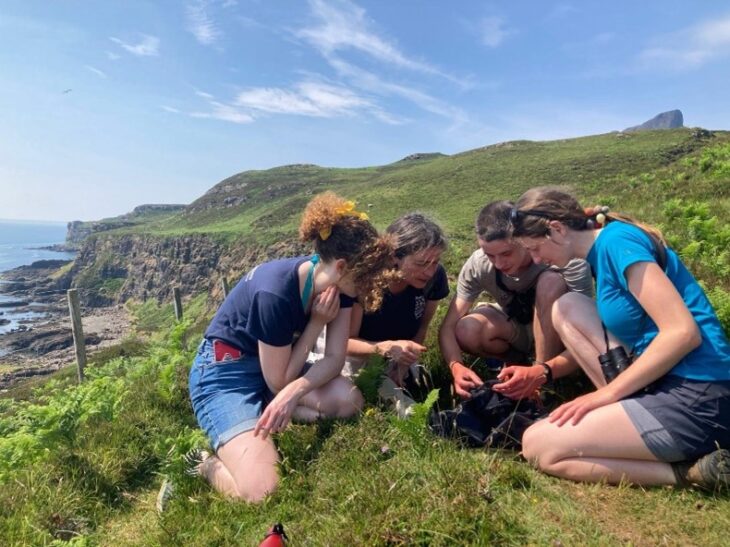Journeys on Eigg
Marco Dobson is a 19-year-old ecology student from North-West England who was one of our volunteer rangers on the Isle of Eigg during May to June 2023. He shares the special summer he spent on the island.

It was a deep passion for botany, wildlife and a longing for somewhere remote that brought me to the island, and Eigg was magnificent in providing all three. I found the Scottish Wildlife Trust’s Isle of Eigg Nature Reserve such an inspiring model for how our lives can be enriched both socially and ecologically for reasons I will continue to explain. I have only the highest regard for the islanders, and their persistence to make Eigg such a special place, and the Scottish Wildlife Trust can surely be proud to be involved too.

It was in mid-May that I arrived on Eigg, on a wonderful sunny day, to be greeted off the ferry by Norah, the Trust’s Isle of Eigg Ranger, along with fellow volunteers and local island characters. I was immediately hit by the community spirit from the moment I stepped off the ferry, with people who I’ve never even met before, offering their help to transport me and my belongings to the volunteer accommodation. This was only then topped by the sighting of a pair of golden eagles over my new ‘home’, as though they greeted me into the community, flying above the vertical cliffs that backed the house. And this was just the start!

As Isle of Eigg rangers, my fellow volunteers and I were tasked in keeping records of all the wildlife on the island. Every day, we would record all our sightings and their locations, so that we knew all the comings, goings and seasonal occurrences of the flora, fauna and fungi of the island. This consisted of recording the species, adults or juveniles, their abundance, the location and any notable or interesting behaviour. All these factors combined could inform us of potential breeding sites, breeding success, survival rate, particular strong holds for rare and endangered species. Every day was a learning experience, as we were not only looking, but seeing the buzz of activity that engulfed the island, it was almost like tuning into a different channel devoted to the extra-human life. It was stark, quite how close we were to wildlife and wild places, with every turn revealing a new surprise. We were incredibly lucky to have the constant background chatter of sedge warblers, melting through our open windows in the volunteer accommodation, which was accompanied by the bubbling call of the curlew and the high pitch piping of common sandpipers, softening the boundary of what we considered home.

One of our tasks as a team was looking for the rare transparent burnet moth (Zygaena purpuralis), of which we were very lucky one day, to find thirty three buzzing around the coastal slopes of Eigg. Read more in Maya Saunder’s blog.

There were a number of days where we volunteers were taken on trips by Norah to see some spectacular spots on Eigg. One outing saw us trudging up steep slopes of deep bracken and heather, with no paths to lead us, relying on the ‘mind map’ engrained into Norah’s memory to find the way. Along our journey, we were finding spectacular plants like mountain avens, pyramidal bugle and kidney vetch, each one special in its own right, but together spoiling us with botanical exuberance. This served only to excite us even more for what we were actually here for – white-tailed eagles! After around an hour and a half of walking through vegetation, we reached a vantage point where we could look back to see cliff faces towering frighteningly high. No sooner had we arrived, two enormous ‘barn doors’ shaved the cliff faces with their wing tips, staring directly at us through the lenses of binoculars. Norah set up the telescope and ushered us to take a look. Peering down the scope so carefully positioned, a white-tailed eagle nest was revealed, the starkness of the cliff broken by an astonishing young fluffy eagle chick! To this day, we volunteers cannot believe our luck at seeing such a thing!

Having spent my days observing other living beings, I became familiar with the species of Eigg (given that it is an island, it does not have all the species that mainland Britain does). I was tasked in recording certain species of interest that were not too common on Eigg, like the blackcap, so we could estimate how many pairs and individuals Eigg supported. However, given my passion for wild plants, Norah supported my interests and encouraged me to record the island’s flora too. It was one day we were out surveying for rare wetland birds, that I stumbled upon a rather bright interesting little plant, growing in a patch of seemingly hostile bare gravel, with little soil or moisture visible to the naked eye. This plant turned out to be sedum villosum, and unbeknown to me, was the first record for the vice county, but it seemed only appropriate that it occurred on Eigg. However, I found that the whole island was botanically astonishing, as you needn’t go far to be walking through a completely different habitat with different vegetation types. I was spoiled with treats like moss campion, globe flower, dwarf willow, sundews and creeping willow. The list is endless!

Throughout my time on Eigg, so much was learned. Never being far from the sea, I learnt so much about marine flora and fauna, and gained valuable experience doing land based marine surveys. In addition, we volunteers got the opportunity to use a moth trap to record and monitor the moths residing on Eigg, which provided a deeper level of ecological knowledge in a whole new nocturnal world. However, it was not only lessons in ecology and conservation that were being taught here. We were also taught about island life and community cooperation. Never had it been so clear, how few so-called human ‘necessities’ we actually need, and thus living on the island has taught me to be resilient, adaptable, resourceful and less wasteful. Being a volunteer ranger on the Isle of Eigg has developed my professional skills and employability, but most importantly developed me as a person. I cannot think of a more special place to spend a summer!
I will forever be thankful for such an incredible experience, an incredible opportunity, incredible wildlife, incredible people, and an incredible Norah, who is such credit to the Scottish Wildlife Trust and the Isle of Eigg. Thank you!
By Marco Dobson
Help protect Scotland’s wildlife
Our work to save Scotland’s wildlife is made possible thanks to the generosity of our members and supporters.
Join today from just £3 a month to help protect the species you love.
Preface
Marco Dobson is a 19-year-old ecology student from North-West England who was one of our volunteer rangers on the Isle of Eigg during May to June 2023. He shares the …
